Philadelphia Trolley Tracks:
Philadelphia Trolley Beginnings
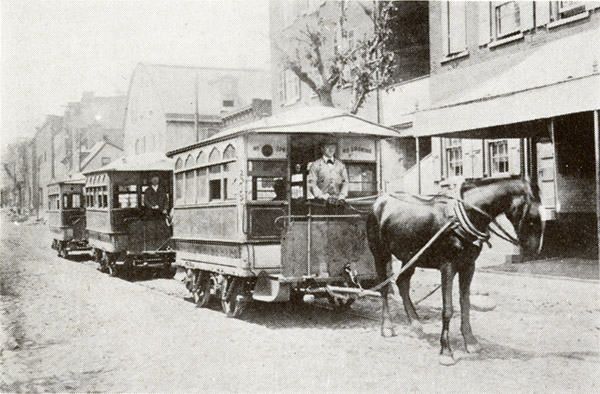
Click on the images to see
enlargements with captions.
A history of the origins of trolleys in Philadelphia
based on an article that appeared in the November 1924 issue of Brill Magazine
In 1858, Philadelphia's first horse-drawn
street railway was started by the Philadelphia & Delaware River Railroad. The
P&DR had been incorporated four years prior, in 1854, primarily for the construction
of a steam railroad between Philadelphia and Easton. After abandoning its original
plan, this company constructed a horse railway line on Fifth and Sixth Streets
from Kensington to Southwark (or as far south as what is now known as Morris
Street). A few months later the company name was changed to the Frankford &
Southwark Philadelphia City Passenger Railroad Company.
Two other companies -- Philadelphia & Darby Railway Company and West Philadelphia
Passenger Railway Company -- were incorporated in 1857. Both commenced construction of their tracks the same year, on Woodland
Avenue and on Market Street respectively.
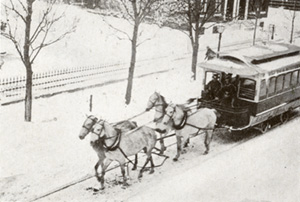 During the 1857 the following nine
companies were incorporated:
During the 1857 the following nine
companies were incorporated:
Citizens Passenger Railway Company
(10th and 11th Streets)
Philadelphia & Grays Ferry Passenger
Railway Company (Spruce and Pine Streets)
2nd & 3rd Streets Passenger Railway
Company (2nd and 3rd Streets)
Fairmount Passenger Railway Company (Race and Vine Streets)
Fairmount & Arch Streets Passenger Railway Company (Arch Street)
Girard College Passenger Railway Company (Ridge Avenue south from Girard College)
Germantown Passenger Railway Company
(Germantown Avenue, 4th and 8th Streets)
Green & Coates Streets Philadelphia
Passenger Railway Company (Green Street and Fairmount Avenue)
Central Passenger Railway Company (Chestnut and Walnut Streets)
The charter of the latter company was repealed the following year.
Following the incorporation in 1859
of six additional horse car lines, it became apparent that unrestricted competition
in such a small area tended toward unsatisfactory service to the public. This
resulted in the organization of the Board of Presidents of Street Railway Companies
the following year. The Board of Presidents created a satisfactory working agreement
among the independent companies as to the various problems of operation. This
board remained active until 1895 when the policy of unity it was created to
maintain was perpetuated by actual merger of many companies into the Union Traction
Company.
The first attempt to digress from horse car operation in
Philadelphia was made as early as 1863 when a steam dummy line was opened along Kensington Avenue between
Kensington and Frankford. This was followed in 1877 by a steam-powered streetcar line on Market Street
between the Delaware River and the Permanent Exhibition Buildings in Fairmount Park. This installation, however,
could hardly be called successful and it was apparent that some other motive power would be required to speed
up transportation to meet the needs of a rapidly growing city.
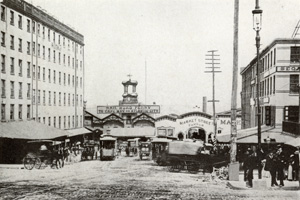 In April, 1883, the first cable
car line in the City of Philadelphia was opened on Columbia Avenue from 23rd
Street to Fairmount Park by the Philadelphia Traction Company, which had been
incorporated the same year. Three years later, this experimental line was extended
to Market Street ferry terminal via Columbia Avenue, 7th, 9th, and Market Streets, and subsequently
in 1888 south from Market Street on 7th and 9th Streets to McKean Street.
In April, 1883, the first cable
car line in the City of Philadelphia was opened on Columbia Avenue from 23rd
Street to Fairmount Park by the Philadelphia Traction Company, which had been
incorporated the same year. Three years later, this experimental line was extended
to Market Street ferry terminal via Columbia Avenue, 7th, 9th, and Market Streets, and subsequently
in 1888 south from Market Street on 7th and 9th Streets to McKean Street.
About this time electricity had been advocated as motive power
for street railway cars and the same enterprising spirit which had prompted the Philadelphia Traction Company
in its cable car experiment was responsible for the introduction December 15, 1892 of the first electric cars
in the city. It had acquired control by lease of the Catherine & Bainbridge Street Passenger Railway Company
in March, 1890 for this purpose but it was not until almost three years later that the first cars were place in
operation on this line. The success which attended this innovation, however, started many existing lines in the
city on a program of electrification and by 1897 the last horse car in the city was run over the Callowhill
Street line.
Between 1854 and 1895 some sixty-six different street railway
companies were incorporated for service in Philadelphia and, while some never commenced operation and
others were absorbed by merger, the Union Traction Company was incorporated September 6, 1895. It leased
Philadelphia Traction Company, comprising nineteen subsidiaries and the Peoples Traction and the Electric
Traction Companies, comprising nine and six subsidiaries respectively. Four years later the Board of
Presidents held their last meeting, the merging of many companies into the Union Traction Company making
it practically useless for them to continue.
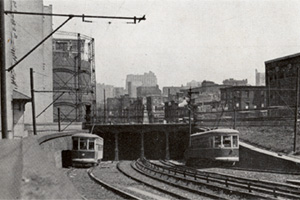 The Union Traction Company figured
prominently among Philadelphia's street railways until July 1, 1902 when it
was leased to the Philadelphia Rapid Transit Company. PRT had been organized
May 1 the same year to coordinate existing transportation lines into one unified
system and to promote additional transportation facilities. On January 1, 1903
the Market Street Elevated Railway Company was leased and work on the first
section of the Market Street Subway between 23rd and 15th Streets was started
a few months later. The following year work on the elevated structure west of
the Schuylkill River was started, being completed to 69th Street in December,
1906. Work on the subway east of 15th Street to 2nd Street, and on the Delaware
Avenue section of the Market Street Elevated, was started in 1906. In 1907 the
subway-elevated service between 15th and 69th Streets was opened for operation.
The eastern end of the high-speed line under Market Street and over Delaware
Avenue to South Street was opened on October 4, 1908 giving a subway-elevated
line 7.35 miles long.
The Union Traction Company figured
prominently among Philadelphia's street railways until July 1, 1902 when it
was leased to the Philadelphia Rapid Transit Company. PRT had been organized
May 1 the same year to coordinate existing transportation lines into one unified
system and to promote additional transportation facilities. On January 1, 1903
the Market Street Elevated Railway Company was leased and work on the first
section of the Market Street Subway between 23rd and 15th Streets was started
a few months later. The following year work on the elevated structure west of
the Schuylkill River was started, being completed to 69th Street in December,
1906. Work on the subway east of 15th Street to 2nd Street, and on the Delaware
Avenue section of the Market Street Elevated, was started in 1906. In 1907 the
subway-elevated service between 15th and 69th Streets was opened for operation.
The eastern end of the high-speed line under Market Street and over Delaware
Avenue to South Street was opened on October 4, 1908 giving a subway-elevated
line 7.35 miles long.
At the time the Philadelphia Rapid Transit Company
was organized in 1902, the city had a population of 1,349,923 served by 2,932 trolley cars (1,698 closed,
1,234 open), most of which were of the single truck (four-wheel) type; over 475 miles of single track. The
advantages to be had by unification of all street railway transportation lines were apparent: the
elimination of waste, coordination which permits better travel facilities to the public, and
progressive development of transportation to meet the expanding requirements of the city and its
environs. In outlying districts new enterprises were acquired. The Darby & Yeadon Street Railway
Company was incorporated June 15, 1904 and leased the same day to the PRT Company. It also acquired
by lease the same year the Philadelphia & Willow Grove Street Railway Company and in July, 1906 took
over the Darby, Media & Chester Street Railway. Additional facilities required commencing
February, 1911 when under an operating agreement, the Chester & Philadelphia Railway was taken over,
followed the next year by the Snyder Avenue Railway which had been leased to the Union Traction
Company.
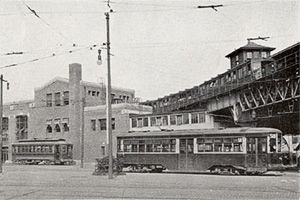 In 1911 the company began a program
of rolling stock replacement which is responsible for the high standard of efficiency
which is characteristic of the company's equipment today [1924]. Over 3,000
trolley cars are now owned by the PRT Co. of which all (with the exception of
40 cars) are of the double-truck type.
In 1911 the company began a program
of rolling stock replacement which is responsible for the high standard of efficiency
which is characteristic of the company's equipment today [1924]. Over 3,000
trolley cars are now owned by the PRT Co. of which all (with the exception of
40 cars) are of the double-truck type.
On November 5, 1922 the Frankford Elevated extension, comprising 6-1/2 miles additional
high-speed lines, was opened for public service. This modern elevated structure extends from Bridge Street, Frankford to the foot of Arch
Street where it connects with the Market Street Subway, providing a service between Frankford in the northeast section of the city and the
69th Street Station, the western terminus, a distance of 13.77 miles.
The combined railway system operated by the company at the present time [1924] comprises
696 miles single track, an increase of 221 miles since the company was organized in 1902. The number of passengers carried in 1902 was
344,252,819 while during the past year a total of 917,787,235 passengers was reached. This is an increase of 166.60% and indicates
more than anything else the expansion which has taken place in the city and the increased demand which is made upon the company's facilities.
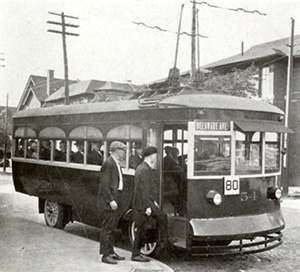 In September, 1923 the Philadelphia Rural Transit Company, a subsidiary of the Philadelphia
Rapid Transit Company, commenced operation of a motorbus
service on the Roosevelt Boulevard, utilizing twenty double-deck buses over a
route 9.7 miles long. Also, the following month another subsidiary, the Pennsylvania Rapid Transit Company, commenced operation on Oregon
Avenue utilizing seven Rail-less cars over a six-mile route as a feeder to a number of intersecting cross-town street railway lines.
In September, 1923 the Philadelphia Rural Transit Company, a subsidiary of the Philadelphia
Rapid Transit Company, commenced operation of a motorbus
service on the Roosevelt Boulevard, utilizing twenty double-deck buses over a
route 9.7 miles long. Also, the following month another subsidiary, the Pennsylvania Rapid Transit Company, commenced operation on Oregon
Avenue utilizing seven Rail-less cars over a six-mile route as a feeder to a number of intersecting cross-town street railway lines.
These two enterprises reflect the company's progressive policy of providing necessary
public transportation assuring the citizens of Philadelphia the reliable and efficient co-ordinated service of which only such an
organization as represented by the Philadelphia Rapid Transit Company is capable.
Editor's note: The future
may have looked bright in 1924 but PRT's fortunes would do a full turnabout
within five years. Just days after the filing of a City lawsuit inquiring into
PRT's and Mitten's finances, on October 1, 1929 Thomas E. Mitten was found drowned
in a lake in upstate Pennsylvania. After lengthy court proceedings PRT was ordered
into receivership. Although there had been ongoing efforts to bring the transit
system under City control -- Philadelphia Consolidated Railways Company was
to be the new entity's title -- in 1935 the courts decreed that the company
would remain a private enterprise. The final day for PRT would be the last day
of 1939. On January 1, 1940 Philadelphia Transportation Company (PTC) was born.
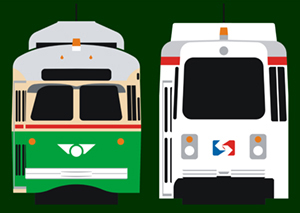
Return to Philadelphia Trolley
Tracks main page.





